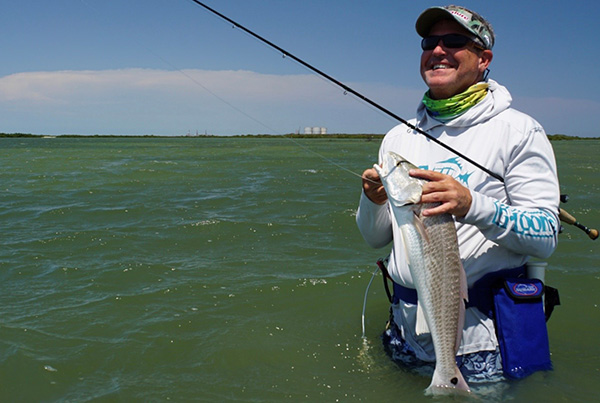Lure Color Doesn’t Matter….Until It Does
The sorrow and suffering of when lure color matters.
By Pat Murray, CCA National President | TIDE | June/July 2020
I hate when lure color matters.
Many, many times it is largely meaningless, but there are times when it matters….sometimes a lot.
We have all experienced it. You stand in your boat or on a shoreline or flat watching another angler who is dialed in on the fish. At first you convince yourself that he or she is merely on an isolated school and you subconsciously (or maybe slightly consciously) ease their direction. Bracing for your turn, you confidently work away waiting for the bite that never comes. You think “Maybe I just need to slow it down a little.”
No luck, and you keep slowly oozing toward magic man. Eventually, you stoop to desperation and shout the question of shame. “Hey pal, whatcha throwing?”
It’s a horrible sinking moment brought on by the desperation of failed angling. I’m actually not even sure why any one of us would even ask. Invariably, the angler is wrapped in imperious glory and either will choose to ignore you entirely or will yell back something like “a jig.” It’s a debasing moment that leads you to spend your entire next paycheck at the fishing tackle store to buy every lure that looks even vaguely like the faint images you had of Captain Fantastic’s miracle lure. It’s the reason that tackle stores have rows and rows of bait color choices.
Think about it. If it really didn’t matter as much as I wish it didn’t, a fishing tackle shop would fit in a small apartment rather than sprawling like a department store featuring every shade imaginable.
The main problem with lure color mattering is that it introduces the shadow of doubt into all the times that you are not getting bites. “Maybe I should have tried the crispy-lemon-chicken-sunrise paddle tail and I would have definitely caught fish.” I get this dialectic rolling in my head that maybe if I had a different bait I would be getting bites, but if I constantly change baits I am not focusing on actually patterning the fish, but maybe the fish won’t bite this bait regardless of my efforts to pattern, so maybe I should change baits….it’s a brutal feedback loop.
I can live with the fact that bait style can actually matter, but color is a lot harder to accept. If I choose to throw a topwater all day and never try a jig or spoon, that is my self-limiting choice. I know that a number of bait choices will regularly not produce even when you are on fish and other baits will more readily produce. That’s okay. But if color choice is the problem? That’s an angler’s nightmare.
So, how do you combat it?
I think every angler has to acknowledge general patterns in color selection. Regardless of if you are pulling plastic for blue marlin or dabbling a 1/32-ounce jig for bluegill, there are general themes that are worth adhering to in your color selection.
Make sure you fill out both of the diverse spectrums of dark and light shades. That may appear a bit overly simplistic, but I believe it helps break down color selection into two broad categories. When you think dark, target the dark reds, plums, and the important shades and versions of black. These choices tend to provide little to no transparency and logically have a full silhouette for both jigs and plugs. It is not coincidental that dark colors can be particularly effective in off-color water. I presume the deeper shade presents the broadest presence.
To me, the light category can be as literal as a clear glow or subtly shaded chartreuse or natural light brown or gray. These parts of the color spectrum are logically going to present a subtle shade. My confidence is highest with these colors in relatively to extremely clear water. I am particularly fond of glow and light chartreuse with air-clear water.
Also, never forget the classics. For years, the two go-to choices in soft plastics were strawberry with a white tail and root beer with a reddish orange tail. With topwaters, bone has been the stalwart and chrome was likely the first truly popular color when topwaters emerged in the saltwater environment. These classic combinations and shades are classics for a reason. They consistently work. It is funny that you do not see those color patterns (particularly strawberry with white tail) used consistently among contemporary anglers. As with a lot of classics, it is not the fish that evolved out of susceptibility to those baits. It is the angler.
Remember too that color patterns can get hot and cold. I vividly remember a period many years ago when a red topwater was critical for producing trout in the Bolivar Pocket. This unique flat on the Gulf side of Galveston’s North Jetty is an odd union of bay and Gulf that can be an incredible wadefishing spot throughout the summer. This particular summer, the fish noticeably preferred red topwaters. I have no clue why, but it really mattered as much as five-to-one, so I painted, dyed and stained everything this side of my boat hull with red ink, fingernail polish and paint. I had more red baits in my boxes and on my customers’ lines than all other colors combined. It was a deadly pattern, until it wasn’t. As quickly as that pattern emerged, it seemed to go the opposite direction, and I had painted and red markered every chrome bait I had. The pattern was real and I had to go with it, but ultimately, it reverted back. I believe the lesson in this is be open to new designs, shades and combinations for sure, but with limited space in any wading belt box and countless colors of tails, plugs, topwaters and spoons available, stick to baits that you know consistently get results.
There is a great line that marksmanship in archery is all about the archer and little to do with the arrow. Obviously, you have to have a fairly good arrow to hit your mark, but it is the archer who has the majority of the influence on what hits the target or not. Color selection will always matter, but confidence and skill always beat color. So if you truly try to answer the question “How to combat the fact that color matters?” The short answer is, “Don’t.” Stick to the basics that bring you the highest confidence factor. Focus on developing your angling skill and ability to pattern fish, and color selection will fade in importance (pun intended).








